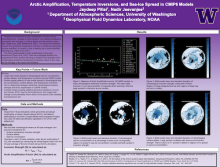Arctic Amplification Not Constrained By Mean-State Wintertime Surface Temperature Inversions
Jaydeep
Pillai
University of Washington, Seattle, Department of Atmospheric Sciences
Poster
Studies on polar amplification over recent years have focused on the physical mechanisms responsible for warming the arctic region and melting sea-ice. Proposed mechanisms include sea-ice thermodynamics, atmospheric heat transport, and a surface-warming induced positive lapse-rate feedback. Inter-model comparisons of spread in polar amplification, however, have lagged behind. In particular, the role of wintertime temperature inversions has come up in recent years as a diagnostic for the patterns of warming found in the arctic. Erosion of this wintertime inversion (through surface-based warming) would give an indication of the level of amplified warming found in the arctic versus the rest of the world. We find there is no relationship between wintertime climatological inversion strength and arctic amplification. We also investigate other arctic variables and find the intermodel spread in sea-ice concentration, surface albedo, and aforementioned temperature inversions to be spatially similar among CMIP6 model members. Further work is needed to analyze the relationship for the spread in model output.

pillai-jay-polar-poster.pdf
(816.98 KB)
